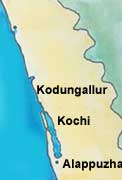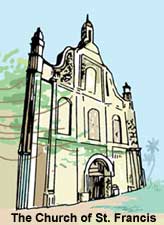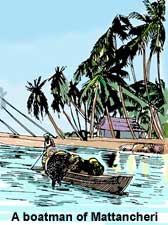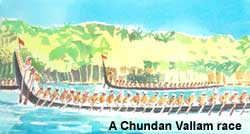
Dimdima
Online Children's Magazine from India

Dimdima
Online Children's Magazine from India

Our journey along the Malabar coast takes us to the most historical of Kerala's ancient ports - Kodungallur or Cranganore, known in ancient times as Muziris.
The port of Muziris served the Phoenicians, Egyptians, Arabs, Greeks and Romans, who brought robes, eye-pigments, copper, brassware and wine and took back besides pepper, Malabar monkeys, tigers, parrots and elephants.
 The first Jews landed at Kodungallur more than 2000 years ago. Christianity was introduced to Kerala by St. Thomas, the Apostle, who arrived at Kodungallur in 52 A.D. The first mosque was built at Kodungallur in 800 A.D. by the last Chera king, Cheraman Perumal, who embraced Islam. It is a simple, tile-roofed mosque, made of wood and stone. It does not have a minaret or a dome like other mosques and it faces the east and not Mecca. A huge bronze lamp, the type found in the temples of Kerala, is kept lighted inside the mosque.
The first Jews landed at Kodungallur more than 2000 years ago. Christianity was introduced to Kerala by St. Thomas, the Apostle, who arrived at Kodungallur in 52 A.D. The first mosque was built at Kodungallur in 800 A.D. by the last Chera king, Cheraman Perumal, who embraced Islam. It is a simple, tile-roofed mosque, made of wood and stone. It does not have a minaret or a dome like other mosques and it faces the east and not Mecca. A huge bronze lamp, the type found in the temples of Kerala, is kept lighted inside the mosque.
Kodungallur is important to Hindus because the Bhadrakali temple, the most important shrine dedicated to the Mother Goddess, who is believed to guard Kerala's shores, is located here.
In 1341, a devastating flood in the Periyar river choked the mouth of Kodungallur's harbour and made it useless for trade purposes. The river changed its course and forced its way into the sea opening up the Kochi harbour.
The harbour at Kochi is one of the finest in the world and is called the 'Queen of the Arabian Sea'. It offers complete protection against the fury of the monsoons.
Kochi comprises a number of islands and a part of the mainland. The Willingdon island which was dredged from the sea bed, the Bolghatty island and the Vypin island (where Chinese fishing nets can be seen billowing against the skyline) are three of these islands.
The Chinese fishing net was introduced into Kerala by traders from Kublai Khan's court. The huge net is lowered into the water on the end of a pole, which rotates about a fulcrum. A lantern on top attracts fish into the meshes. At least half a dozen men are needed at the other end of the pole to lift the haul out.
Fort Kochi, which lies by the side of the harbour on the mainland is believed to be the oldest European settlement in India.
The Church of St. Francis, built by the Portuguese in 1510, is the oldest existing European church in the country. The mortal remains of Vasco da Gama, who died at Kochi in 1524, were interred in this church. His gravestone, enclosed by polished brass railings, can be seen on the church's southern side. His body, however, was taken to Portugal by his son in 1538.
Mattancheri, to the south of Fort Kochi, is the home of the Kerala Jews. The number of Jews has fallen drastically as many of them have migrated to Israel, The Jewish colony at Mattancheri was established in the 4th century A.D. The synagogue, called the Paradesi synagogue, was built around 430 years back. A clock tower, built in the mid-18th century dominates the synagogue.
Close to the synagogue is the double-storeyed Mattancheri
Palace, whose inner walls are decorated with murals depicting the Ramayana and the Mahabharata. A part of the palace serves as a museum housing palanquins and royal costumes used by the Kochi maharajas.
The palace was earlier called the Dutch Palace although it was not built by the Dutch. It was constructed by the Portuguese as a peace offering to the Raja of Kochi, whose palace they had destroyed. The Dutch however, renovated the palace adding the typical Dutch-style roof to the structure.
The palace's floor gives the impression of being made of polished black marble, but is actually made from a mixture of burnt coconut shells, charcoal, lime, plant juices and egg whites. The art of making such flooring, unique to Kerala, has been lost over the years and there are very few places where it can be seen today.
From Kochi all the way southwards to Kollam one can see a continuous chain of lagoonS and backwaters. The Vembanad lake, stretching from Kochi to Alappuzha and covering an area of 79 sq.miles, is the biggest expanse of backwaters in Kerala.
In the months of August and September, the banks of Alappuzha's backwaters throng with people who come to watch the spectacular 'Chundan Vallam' or snakeboat race. The 130-1eet-long beak-shaped, steel-bowed vallams manned by over a 100 rowers move at breakneck speeds accompanied by gutsy roars. The most famous of these races, the Nehru Trophy Boat Race, takes place on Independence Day to commemorate the visit of Pandit Jawaharlal Nehru to the state. The people of neighbouring Kuttanad (the rice bowl of Kerala) entertained him with a snakeboat race held on the outskirts of Alappuzha. Nehru was so thrilled with the display that he got into the boat that had won the race and sailed on to the Alappuzha boat jetty, disregarding all security arrangements.
After returning to Delhi, he sent a silver trophy to the then chief minister asking him to present it to the winner of the boat race to be held every year at the same place.

Last updated on :3/31/2005
Dimdima is the Sanskrit word for ‘drumbeat’. In olden days, victory in battle was heralded by the beat of drums or any important news to be conveyed to the people used to be accompanied with drumbeats.
Bharatiya Vidya Bhavan
K. M Munshi Marg,
Chowpatty, Mumbai - 400 007
email : editor@dimdima.com
Bharatiya Vidya Bhavan
505, Sane Guruji Marg,
Tardeo, Mumbai - 400 034
email : promo@dimdima.com
Dimdima.com, the Children's Website of Bharatiya Vidya Bhavan launched in 2000 and came out with a Printed version of Dimdima Magazine in 2004. At present the Printed Version have more than 35,000 subscribers from India and Abroad.